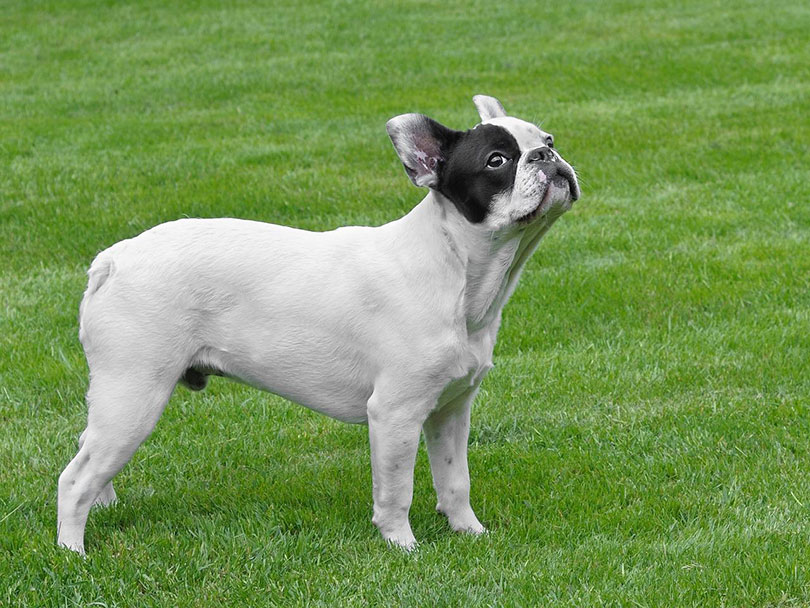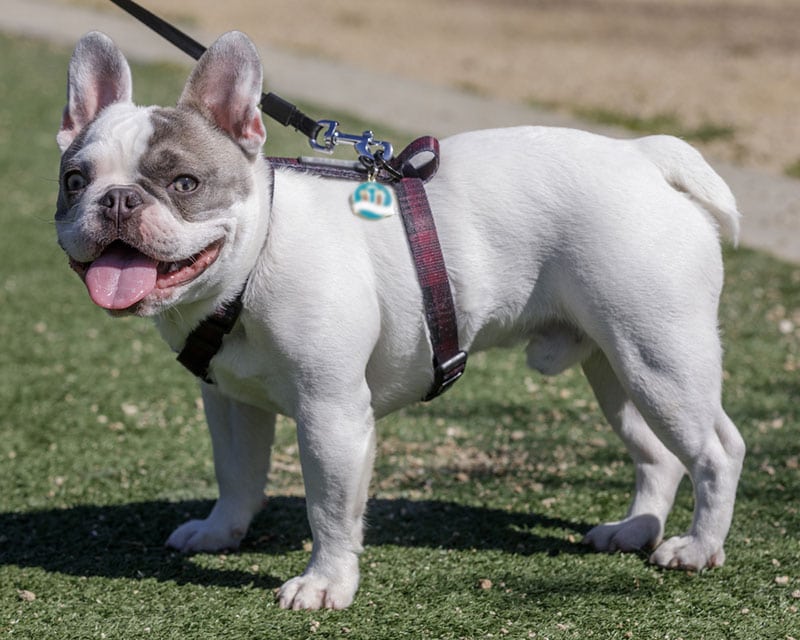Click to Skip Ahead
Pied French Bulldogs, or Piebald French Bulldogs, are wonderful companion dogs with adorable unique markings on their coats. They’re less common than French Bulldogs with solid-colored coats, so it’s always extra special when you meet a Pied French Bulldog.
The popularity of Pied French Bulldogs has grown exponentially in the US. Although their popularity in the US has risen in recent years, Pied French Bulldogs have had a strong international fanbase for many years. So, whether you’re a new or old fan, we have fun and interesting facts and history that any Pied French Bulldog fan will appreciate knowing.
Breed Overview
Height:
10–12 inches
Weight:
15–28 pounds
Lifespan:
10–12 years
Colors:
White and black, white and gray, white and fawn, white and brindle
Suitable for:
Families with children, apartment dwellers
Temperament:
Loyal & loving, intelligent, easy to train, friendly, gets along with other pets
Pied French Bulldogs get their coat markings from a gene mutation affecting the S locus. Mutations in the S locus can lead to piebald and parti-colored coats. It’s interesting to note that while Pied and Harlequin French Bulldogs may look similar because of their markings, they’re distinct in the sense that they get their markings from different causes. The piebald coat marking is caused by a mutation in the S locus, while the harlequin coat marking is caused by a mutation in the H locus.
Pied French Bulldog Characteristics
The Earliest Records of Pied French Bulldogs in History
The ancestry of Pied French Bulldogs is unclear. However, it’s widely believed that they descended from an ancient dog breed known as the Molossian Hound. These dogs lived alongside humans in Ancient Greece, and the English Mastiff was eventually developed from them. A relative of the English Mastiff, known as the Bullenbeisser, was bred for bull-baiting purposes. Bullenbeissers are the predecessors of the Bulldogs we know today, and the French Bulldog appeared as breeders worked to produce a toy-sized bulldog.
It’s also unclear when Pied French Bulldogs first appeared. Since the piebald marking is caused by a genetic mutation, the first Pied French Bulldogs were likely produced accidentally. It’s important to note that piebaldism is an autosomal dominant trait, so it’s passed down through generations.

How Pied French Bulldogs Gained Popularity
By the mid-1800s, toy-sized Bulldogs got their footing in certain English cities, particularly in Nottingham. During that time, Nottingham was a city for lacemakers, and these toy-sized Bulldogs became popular mascots amongst lacemakers. When the Industrial Revolution started to dissolve the specialized work of lacemaking, lacemakers eventually moved to northern France and took their beloved toy-sized Bulldogs with them.
The toy-sized Bulldogs gained popularity in France and were crossbred with Pugs and other small dog breeds. They eventually made their way to the US by the end of the 19th century, and it was only a matter of time before their popularity reached an international scale.
Formal Recognition of Pied French Bulldogs
The first French Bulldog breed club was founded in 1880 in Paris, France, and the first breed standard was formalized in 1898. The American Kennel Club also officially recognized the French Bulldog in 1898, and the United Kennel Club recognized the breed in 1965.
The Piebald marking is officially recognized by breed standards. So, Pied French Bulldogs are eligible to compete and win in shows. Most recently, Winston the French Bulldog won best-in-show at the 2022 National Dog Show and was the winner of the non-sporting group at the 2023 Westminster Dog Show.
Top 3 Unique Facts About Pied French Bulldogs
1. Pied French Bulldogs don’t originate from France.
Despite having strong associations with France, the French Bulldog has roots in England. Toy-sized Bulldogs were widely bred in England before they followed migrating lacemakers to northern France. There, they grew in popularity and were bred with other small dog breeds to help create the standardized look we know today.
2. French Bulldogs were named the most popular dog in the US in 2022.
The Labrador Retriever had consistently held the number one spot as the US’ favorite dog. For the past few years, the French Bulldog continued to rise in the ranks and kept inching closer and closer to the Labrador Retriever. In 2022, the breed finally became the first dog breed to surpass the Labrador Retriever in decades and was named the most popular dog breed of the year.

3. There are no clear links between the piebald gene and deafness for Pied French Bulldogs.
Due to the complexities of genetics, a dog’s coat type may be a marker for certain health risks. For example, some dog breeds with a merle coat are more susceptible to deafness. When it comes to the piebald gene mutation, researchers have yet to find sufficient evidence that Pied French Bulldogs are more susceptible to certain health issues. They just may be more susceptible to sunburn, but this is because animals with white coats and pink skin are more likely to get sunburn more quickly than animals with darker skin and coats.
Do Pied French Bulldogs Make a Good Pet?
Pied French Bulldogs are known to have easy-going and friendly temperaments. While some may initially have a few stubborn streaks, they’re relatively easy to train. They’re also known to be good with children and often adapt well to living with other pets after proper socialization.
While Pied French Bulldogs have wonderful personalities, they’re often better fits for experienced dog owners because they have specific care needs. As brachycephalic dogs, they can have difficulty breathing in hotter and humid weather and are more susceptible to overheating quickly. Pied French Bulldogs are also prone to weight gain and obesity. So, dog owners must find a good balance between providing their Pied French Bulldogs with adequate amounts of exercise and not overexerting them and feeding them appropriate diets.
Conclusion
There’s no denying that Pied French Bulldogs are adorable companion dogs. They have an interesting and rich history and have provided invaluable joy and companionship to humans for centuries. So, it’s no surprise that they’ve worked their way to becoming America’s most popular dog breed. It’s a well-deserved title, and we look forward to seeing how they’ll continue to contribute to and shape the dog world for many more years to come.
Featured Image Credit: Patryk Kosmider, Shutterstock











